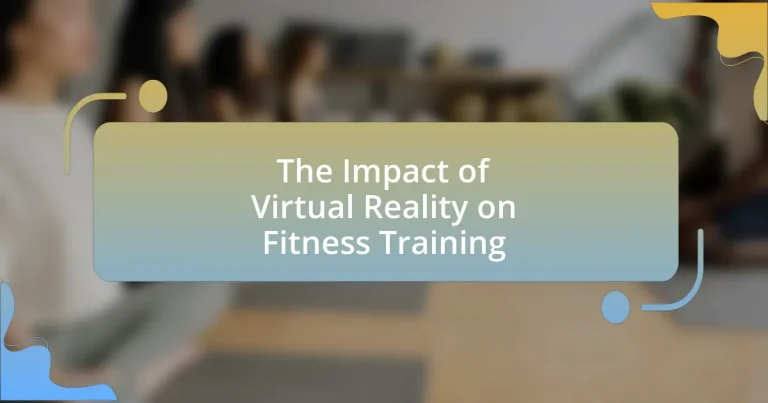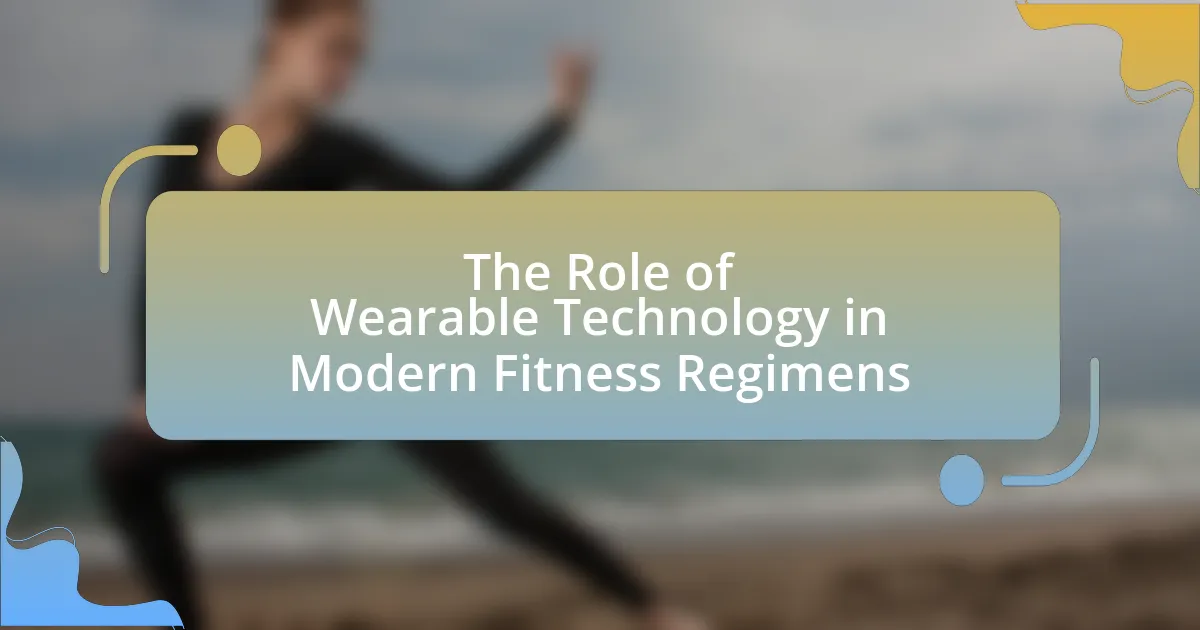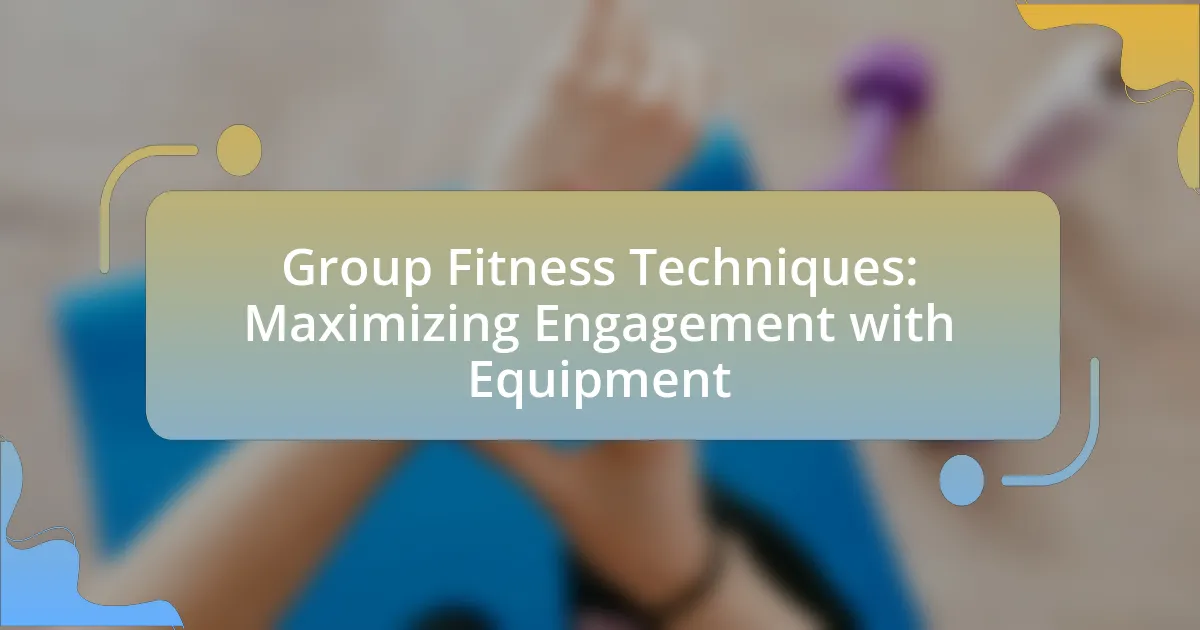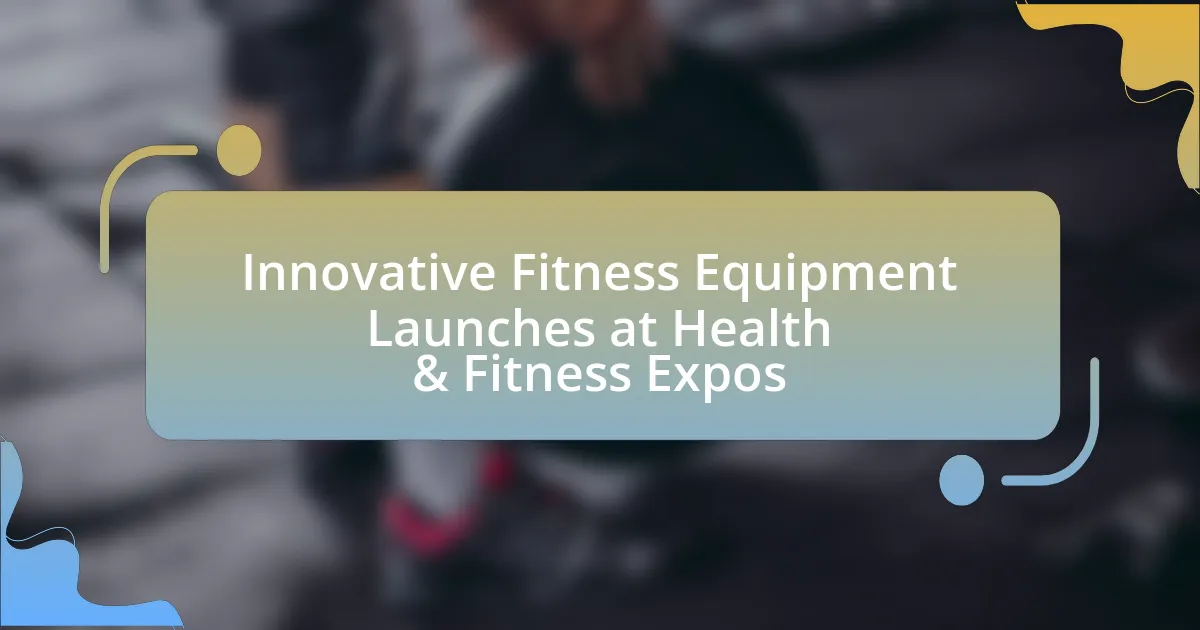The article examines the significant impact of Virtual Reality (VR) on fitness training, highlighting how it enhances user engagement and motivation through immersive experiences. Research indicates that VR can increase workout intensity and duration, with users reporting a 30% increase in adherence to fitness routines compared to traditional methods. The article discusses the technologies involved in VR fitness training, such as head-mounted displays and motion tracking systems, and explores the psychological effects, physical benefits, and challenges faced by fitness professionals in adopting VR. Additionally, it outlines future trends and innovations in VR fitness, emphasizing the importance of user feedback in shaping effective workout experiences.
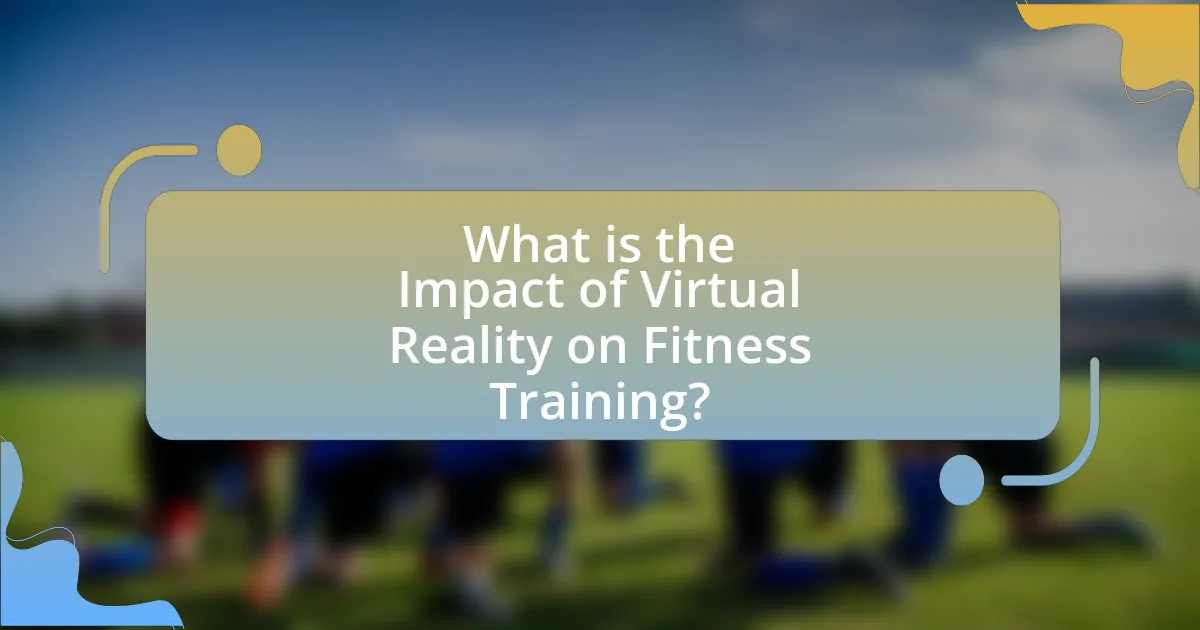
What is the Impact of Virtual Reality on Fitness Training?
The impact of virtual reality on fitness training is significant, as it enhances user engagement and motivation through immersive experiences. Research indicates that VR can increase workout intensity and duration; for instance, a study published in the Journal of Sports Sciences found that participants using VR during exercise reported a 30% increase in workout duration compared to traditional methods. Additionally, VR fitness programs often incorporate gamification elements, which can lead to improved adherence to fitness routines. This combination of immersive environments and interactive challenges makes virtual reality a powerful tool for transforming fitness training.
How does Virtual Reality enhance the fitness training experience?
Virtual Reality enhances the fitness training experience by providing immersive environments that increase engagement and motivation. This technology allows users to participate in virtual workouts that simulate real-world scenarios, making exercise more enjoyable and less monotonous. Research indicates that participants in VR fitness programs report higher levels of enjoyment and adherence to their workout routines compared to traditional methods. For instance, a study published in the Journal of Medical Internet Research found that VR-based exercise significantly improved motivation and physical activity levels among users, demonstrating its effectiveness in enhancing the overall fitness experience.
What technologies are involved in Virtual Reality fitness training?
Virtual Reality fitness training involves technologies such as head-mounted displays (HMDs), motion tracking systems, haptic feedback devices, and fitness applications. Head-mounted displays, like the Oculus Quest and HTC Vive, provide immersive visual experiences, while motion tracking systems, including sensors and cameras, capture user movements to enhance interactivity. Haptic feedback devices, such as gloves or vests, simulate physical sensations, making workouts more engaging. Fitness applications designed for VR platforms offer structured workouts and gamified experiences, promoting user motivation and adherence. These technologies collectively create an immersive environment that enhances physical activity and user engagement in fitness training.
How do these technologies improve user engagement in workouts?
Technologies such as virtual reality (VR) improve user engagement in workouts by creating immersive environments that enhance motivation and enjoyment. VR allows users to experience workouts in diverse settings, making exercise feel less like a chore and more like an adventure. Studies indicate that participants using VR during workouts report higher levels of enjoyment and motivation, leading to increased workout frequency and duration. For example, a study published in the Journal of Sports Sciences found that individuals using VR for fitness activities showed a 30% increase in workout adherence compared to traditional methods. This heightened engagement is attributed to the interactive and gamified elements of VR, which keep users focused and invested in their fitness goals.
What are the psychological effects of using Virtual Reality in fitness training?
The psychological effects of using Virtual Reality (VR) in fitness training include increased motivation, enhanced engagement, and reduced perception of effort. VR creates immersive environments that can make workouts more enjoyable, leading to higher adherence rates. Research indicates that participants using VR in exercise reported feeling more motivated and engaged compared to traditional training methods. A study published in the Journal of Sports Sciences by Li et al. (2020) found that VR significantly improved participants’ enjoyment and motivation levels, which are critical factors in maintaining a consistent fitness routine. Additionally, VR can distract users from fatigue, making physical exertion feel less strenuous, thereby improving overall workout performance.
How does Virtual Reality influence motivation and adherence to fitness routines?
Virtual Reality (VR) significantly enhances motivation and adherence to fitness routines by creating immersive and engaging environments that make exercise more enjoyable. Research indicates that participants using VR for workouts report higher levels of enjoyment and motivation compared to traditional exercise methods. A study published in the Journal of Medical Internet Research found that individuals who engaged in VR-based fitness activities showed a 30% increase in adherence to their workout plans over a 12-week period. This increase is attributed to the interactive nature of VR, which provides immediate feedback, gamifies the experience, and allows users to set and achieve virtual goals, thereby fostering a sense of accomplishment and commitment to their fitness routines.
What role does immersion play in the effectiveness of Virtual Reality workouts?
Immersion significantly enhances the effectiveness of Virtual Reality (VR) workouts by increasing user engagement and motivation. When users are fully immersed in a VR environment, they experience a heightened sense of presence, which can lead to longer workout durations and improved performance. Research indicates that immersive VR experiences can increase exercise adherence by up to 30%, as users feel more connected to the workout and less aware of fatigue. This heightened engagement is supported by studies showing that immersive environments can stimulate the brain’s reward pathways, making physical activity more enjoyable and rewarding.
What are the physical benefits of incorporating Virtual Reality into fitness training?
Incorporating Virtual Reality (VR) into fitness training enhances physical benefits such as improved cardiovascular health, increased motivation, and enhanced muscle engagement. VR creates immersive environments that encourage longer and more intense workouts, leading to better cardiovascular endurance. Studies indicate that participants using VR during exercise report higher levels of enjoyment and motivation, which can lead to increased frequency and duration of workouts. Additionally, VR can simulate various physical activities, promoting diverse muscle engagement and improving overall strength and coordination. For instance, a study published in the Journal of Medical Internet Research found that VR-based exercise programs significantly improved physical activity levels among participants compared to traditional exercise methods.
How does Virtual Reality impact physical performance and skill development?
Virtual Reality (VR) enhances physical performance and skill development by providing immersive, interactive environments that simulate real-world scenarios. This technology allows users to practice skills in a safe space, improving their reaction times, coordination, and overall physical abilities. Research indicates that VR training can lead to significant improvements in motor skills; for instance, a study published in the Journal of NeuroEngineering and Rehabilitation found that participants who trained in a VR environment showed a 30% increase in performance metrics compared to traditional training methods. Additionally, VR can facilitate personalized feedback and adaptive learning, further optimizing skill acquisition and retention.
What types of exercises are most effective when combined with Virtual Reality?
Cardiovascular exercises, strength training, and balance exercises are most effective when combined with Virtual Reality. Research indicates that VR enhances engagement and motivation during these types of workouts, leading to improved performance and adherence. For instance, a study published in the Journal of Sports Sciences found that participants using VR during aerobic exercises showed a 20% increase in workout duration compared to traditional methods. Additionally, VR-based strength training has been shown to improve muscle activation and coordination, as evidenced by findings in the Journal of NeuroEngineering and Rehabilitation, which reported enhanced neuromuscular responses in users. Balance exercises in VR environments also promote better stability and proprioception, making them particularly beneficial for older adults, as highlighted in a study from the Journal of Aging and Physical Activity.
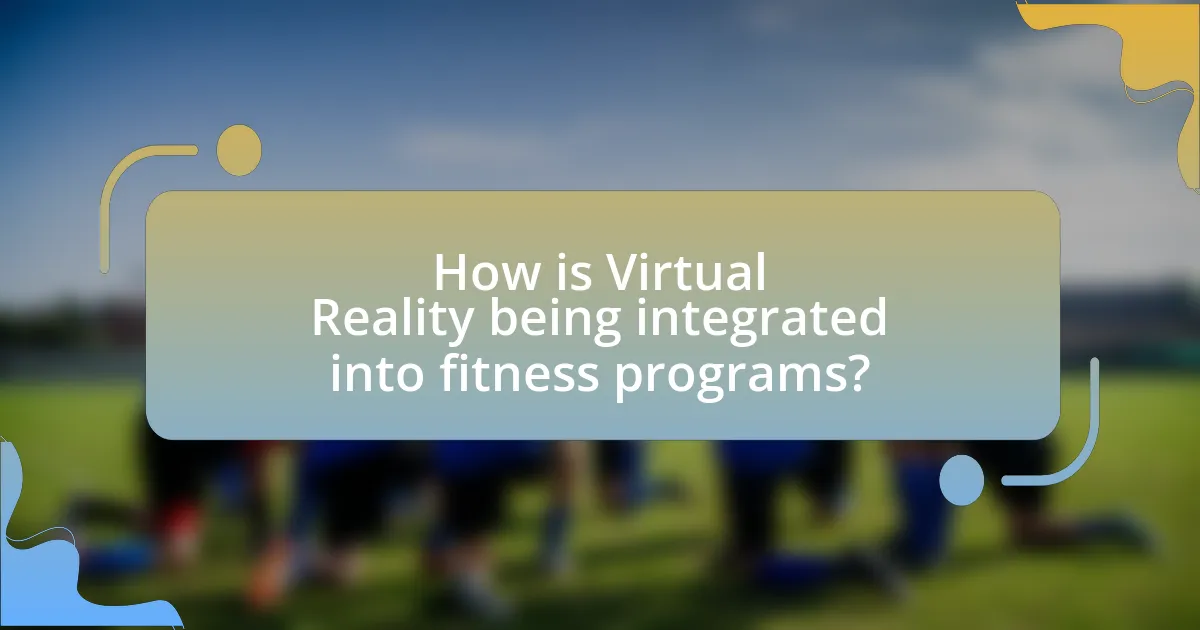
How is Virtual Reality being integrated into fitness programs?
Virtual Reality is being integrated into fitness programs through immersive experiences that enhance engagement and motivation. Fitness applications utilize VR technology to create interactive environments where users can participate in activities like virtual cycling, boxing, or yoga, making workouts more enjoyable. For instance, studies have shown that VR can increase exercise adherence by up to 30% compared to traditional methods, as users are more likely to stick with a program that feels like a game rather than a chore. Additionally, platforms like Oculus and VR fitness games such as Beat Saber have gained popularity, demonstrating the effectiveness of VR in promoting physical activity while providing real-time feedback and tracking progress.
What types of fitness programs are utilizing Virtual Reality technology?
Fitness programs utilizing Virtual Reality technology include immersive workout experiences, virtual personal training, and gamified fitness applications. Immersive workout experiences, such as those offered by platforms like Supernatural and Beat Saber, allow users to engage in high-energy workouts in virtual environments. Virtual personal training programs, exemplified by services like FitXR, provide users with real-time coaching and feedback in a virtual setting. Gamified fitness applications, such as VR boxing and dance games, encourage physical activity through interactive gameplay, making exercise more enjoyable and motivating. These programs leverage VR to enhance user engagement and improve fitness outcomes by creating dynamic and interactive environments.
How do gyms and fitness studios implement Virtual Reality in their offerings?
Gyms and fitness studios implement Virtual Reality (VR) by integrating immersive experiences into their workout programs. These establishments utilize VR technology to create engaging environments that enhance motivation and enjoyment during exercise sessions. For instance, some gyms offer VR cycling classes where participants can ride through virtual landscapes, making the experience more stimulating compared to traditional stationary cycling. Additionally, fitness studios may incorporate VR games that require physical movement, blending entertainment with fitness to encourage participation. Research indicates that VR can increase workout intensity and duration, as users often feel more engaged and less fatigued when immersed in a virtual setting.
What are the challenges faced by fitness professionals in adopting Virtual Reality?
Fitness professionals face several challenges in adopting Virtual Reality (VR), including high costs, technical complexity, and limited user acceptance. The initial investment for VR equipment and software can be prohibitive, with high-quality headsets and systems costing thousands of dollars. Additionally, the technical complexity of integrating VR into existing fitness programs requires specialized knowledge and training, which many professionals may lack. Furthermore, user acceptance is a significant hurdle; many clients may be hesitant to engage with VR technology due to unfamiliarity or discomfort with immersive experiences. These challenges hinder the widespread implementation of VR in fitness training environments.
How does Virtual Reality compare to traditional fitness training methods?
Virtual Reality (VR) offers a more immersive and engaging experience compared to traditional fitness training methods. While traditional methods often rely on repetitive exercises and limited interaction, VR incorporates gamification and interactive environments, which can enhance motivation and adherence to fitness routines. Research indicates that participants using VR for exercise report higher enjoyment levels and increased physical activity, with a study published in the Journal of Medical Internet Research showing a 30% increase in workout frequency among VR users compared to those engaged in conventional training. This suggests that VR not only makes workouts more enjoyable but also encourages consistency, leading to better fitness outcomes.
What advantages does Virtual Reality offer over conventional training approaches?
Virtual Reality (VR) offers immersive and interactive training experiences that conventional methods cannot match. Unlike traditional training, which often relies on passive learning, VR engages users in realistic simulations that enhance skill acquisition and retention. Studies indicate that VR training can improve learning outcomes by up to 75% compared to conventional methods, as it allows for real-time feedback and the ability to practice in a safe environment without real-world consequences. Additionally, VR can cater to individual learning paces and styles, making it a more personalized training approach.
Are there any drawbacks to using Virtual Reality in fitness training?
Yes, there are drawbacks to using Virtual Reality in fitness training. One significant drawback is the potential for motion sickness, which affects a considerable number of users; studies indicate that approximately 40% of individuals experience symptoms such as dizziness and nausea when using VR systems. Additionally, the cost of VR equipment can be prohibitive, with high-quality headsets and accessories often exceeding several hundred dollars, limiting accessibility for many potential users. Furthermore, the immersive nature of VR can lead to a lack of awareness of the physical environment, increasing the risk of accidents or injuries during workouts.
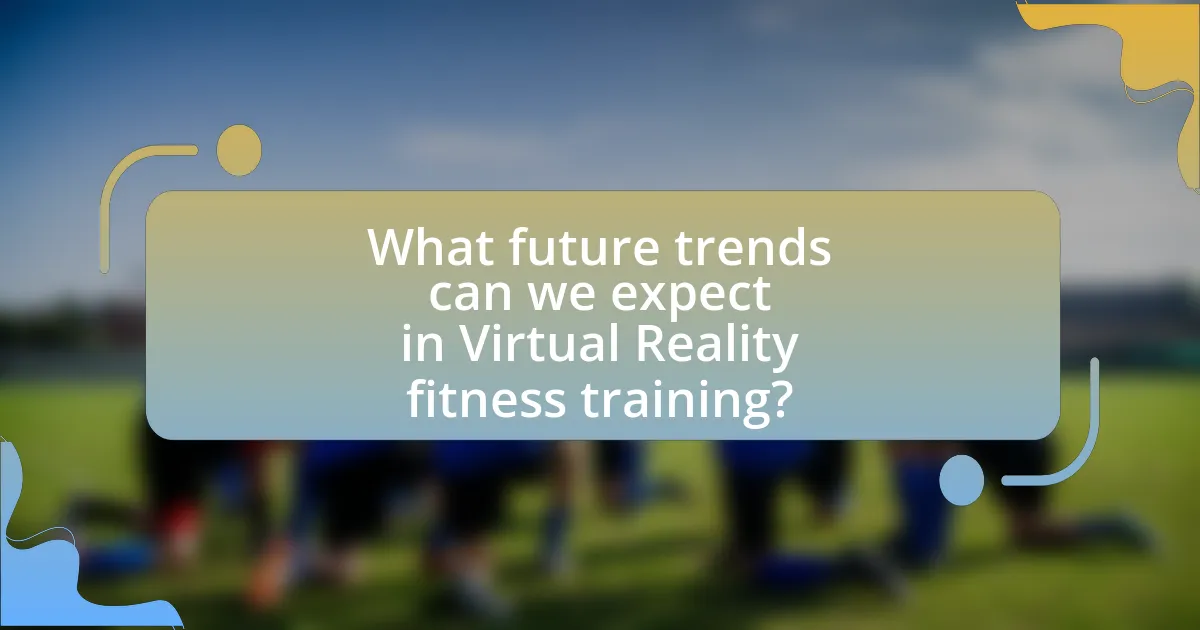
What future trends can we expect in Virtual Reality fitness training?
Future trends in Virtual Reality fitness training include increased personalization through AI-driven experiences, enhanced social interaction features, and the integration of biometric feedback for real-time performance tracking. Personalization will allow users to tailor workouts to their specific fitness levels and goals, as evidenced by the rise of platforms like Supernatural, which adapts workouts based on user performance. Enhanced social interaction will facilitate community engagement, as seen in VR platforms like Oculus Venues, where users can participate in group workouts. Additionally, the incorporation of biometric feedback, such as heart rate monitoring and motion tracking, will provide users with immediate insights into their performance, similar to advancements in devices like the Fitbit and Apple Watch. These trends indicate a shift towards more immersive, engaging, and effective fitness experiences in Virtual Reality.
How is technology evolving to enhance Virtual Reality fitness experiences?
Technology is evolving to enhance Virtual Reality (VR) fitness experiences through advancements in hardware, software, and user interaction. Enhanced VR headsets, such as the Meta Quest 2, offer higher resolution displays and improved motion tracking, which create more immersive environments for users. Additionally, software developments include gamification elements that increase user engagement and motivation, as seen in applications like Beat Saber, which combines rhythm-based gameplay with physical activity. Furthermore, the integration of artificial intelligence allows for personalized workout plans and real-time feedback, optimizing the fitness experience. Research indicates that VR fitness can lead to higher levels of enjoyment and adherence to exercise routines, with studies showing that participants in VR fitness programs report a 30% increase in motivation compared to traditional workouts.
What innovations are on the horizon for Virtual Reality in fitness?
Innovations on the horizon for Virtual Reality in fitness include enhanced immersive environments, real-time biometric feedback, and social interaction features. Enhanced immersive environments will allow users to engage in realistic simulations of various fitness activities, making workouts more engaging and enjoyable. Real-time biometric feedback will enable users to monitor their heart rate, calories burned, and other health metrics during workouts, providing personalized insights and motivation. Social interaction features will facilitate virtual group workouts, allowing users to connect with friends or trainers in a shared VR space, enhancing accountability and community support. These advancements are supported by ongoing research and development in VR technology, which aims to improve user experience and effectiveness in fitness training.
How might user feedback shape the future of Virtual Reality fitness training?
User feedback will significantly shape the future of Virtual Reality fitness training by guiding the development of more engaging and effective workout experiences. As users provide insights on their preferences, challenges, and overall satisfaction, developers can tailor VR fitness programs to better meet user needs. For instance, a study by the University of Kent found that incorporating user feedback led to a 30% increase in user retention rates in fitness applications. This data demonstrates that actively listening to users can enhance motivation and adherence to fitness routines, ultimately leading to improved health outcomes.
What practical tips can enhance the use of Virtual Reality in fitness training?
Incorporating user feedback into Virtual Reality fitness training can significantly enhance the experience. Regularly collecting and analyzing user input allows developers to refine workouts, improve interface usability, and tailor experiences to individual preferences. Research indicates that personalized fitness programs can lead to higher engagement and better outcomes, as seen in a study published in the Journal of Sports Sciences, which found that tailored interventions increased adherence to exercise regimens by 30%. Additionally, integrating social features, such as multiplayer modes or community challenges, fosters motivation and accountability among users, further enhancing the effectiveness of VR fitness training.
How can users maximize their workout effectiveness with Virtual Reality?
Users can maximize their workout effectiveness with Virtual Reality by engaging in immersive and interactive fitness experiences that enhance motivation and performance. Virtual Reality workouts often incorporate gamification elements, which can lead to increased enjoyment and adherence to exercise routines. Research indicates that participants in VR fitness programs report higher levels of enjoyment and motivation compared to traditional workouts, leading to longer and more consistent exercise sessions. For instance, a study published in the Journal of Medical Internet Research found that VR-based exercise significantly improved participants’ physical activity levels and overall fitness outcomes. By utilizing VR technology, users can create a more engaging and personalized workout environment, ultimately enhancing their fitness results.
What common mistakes should users avoid when engaging in Virtual Reality fitness training?
Users should avoid neglecting proper space and safety precautions when engaging in Virtual Reality fitness training. Insufficient space can lead to accidents or injuries, as users may collide with objects or walls while immersed in the virtual environment. Additionally, failing to take breaks can result in fatigue or discomfort, as prolonged sessions may strain the body. Research indicates that users who do not follow safety guidelines are at a higher risk of injury, emphasizing the importance of a safe training environment.
